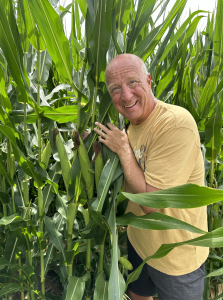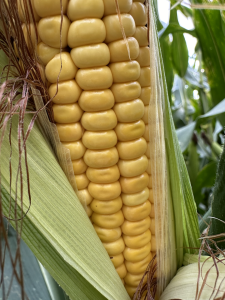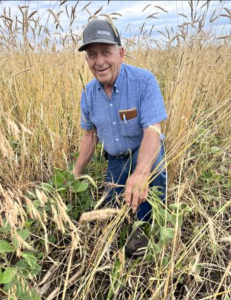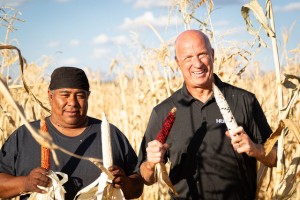It’s National Corn Month! Okay, I know what you’re thinking. Isn’t that every month for me? True. But hey, it’s only fair that we reserve an entire month to recognize USA’s most widely grown crop. Over 90 million acres – about the size of Montana – of corn is grown annually across the fruited plain. And American farmers are really good at growing it, with 300,000 growers producing over 15 billion bushels, or over 840 billion pounds, annually.
So where does all this maize go? Most of our homegrown corn stays at home. Traditionally, the majority of corn went to feed cattle, hogs and poultry. But now, livestock feed is essentially tied with ethanol as the top market, each accounting for 38%. About 9% goes to the more than 4,000 grocery store products that contain corn. And 15% is exported, with our top customers being Mexico, China and Japan. A common misconception is the rows and rows of corn you see driving across the Midwest is enjoyed by people as corn on the cob, frozen or can corn. Truth is, the table corn market only accounts for about 1% of all corn acres. Corn is a tropical grass believed to have originated in Mexico and brought here by Native Americans. More than half of US corn is grown is five states: Iowa, Illinois, Nebraska, Minnesota, and South Dakota. With its fast growth, tall height (often reaching 10-12 feet tall), large leaves, deep green color, and big ears with hundreds of yellow kernels, corn is THE most fun plant to grow. That’s my story and I’m sticking to it.

My corn is reaching another physical milestone: the dent stage (aka R5). This signals the start of maturity, as starches inside the kernels begin to shrink, forming a dent on the crown of the kernel. This does not mean the kernels have stopped growing; they can still absorb plenty of water and nutrients. The kernels still contain about 50% moisture, so there’s plenty of opportunity to add weight. That’s why I irrigated last week, fed the plants the week before last, and will continue to water the crop as needed. We’re probably about three weeks away from physical maturity. There’s a common belief that the shallower the dent atop a kernel, the better. You want the kernels to be as big as possible.

Our good friend Dan Hilger is featured in the current issue of Midwest Messenger. You can read the full article here. At 78 years young, this Nebraska grower is famous for his chemical-free, natural Hilger Agri-Natural Popcorn. But his entrepreneurial spirit extends well beyond these fluffy snacks. He’s been utilizing regen ag practices for decades, focusing on farming the soil, not just the crop. His diversified operation has expanded to not only be a devoted user of cover crops; but raise, custom clean and sell them. Dan holds the distinction of being Huma’s oldest continuous customer, utilizing our biostimulants to improve plant and soil health for 38 years.

The climate smart movement is forming several alliances. The latest connects North America’s largest food company with the world’s largest nitrogen producer. Pepsico and Yara have partnered to decarbonize crop production in Europe. Yara will annually treat 25% of Pepsico-sourced acres (over 300,000 acres) with 165,000 tons of their Climate Choice fertilizers produced from renewable ammonia or low-carbon ammonia via carbon capture and storage.
Related Posts

This Week in Ag #33
In commodity crop production, we talk a lot about bushels per acre. Because that’s how farmers get paid. But what exactly does bushels per acre mean? A bushel is the unit of measure we use in the USA (other parts of the world use tons or metric tons) to calculate yield, verify shipments and set pricing standards for crops such as corn, soybeans, wheat, canola, rice and sorghum. There’s a good chance your grandparents had a bushel basket laying around their house, garage, or barn. If you were to fill that basket to the brim with corn, you’d have one bushel’s worth.

This Week in Ag #41
This is American agriculture’s big week – Thanksgiving! Our celebration of food takes center stage on family dining tables from sea to shining sea. Not only do we honor the 1% who currently feed us, we also reflect upon the many contributions of the original American agriculturalists, our Native Americans. For starters, they saved the Pilgrims from starvation during their first years in the New World. The Wamponoag tribe utilized their famous “Three Sisters” cropping practice: corn, beans and squash.

This Week in Ag #57
“What are you planting this year?” That may not sound like a trick question, considering it’s already mid-March. But ask any farmer south of the Mason-Dixon line that question and you’ll likely see their shoulders shrug. You see, unlike in the West, where permanent crops and processor contracts make planting decisions more straight-forward, or in the

